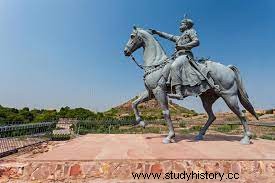
unsolved mystery
Rao Siha, the ancestor of Rao Jodha was the first person who came to Marwar. He started the work of establishing his kingdom in the desert. There are strong differences among historians regarding who Siha was and where he came from. The Rathores of Marwar have been believed to be the children of Siha, a descendant of King Jaychand of Kannauj. Chand Bardai, in his book Prithviraj Raso, has described King Vijaychandra and Jayachandra of Kannauj as the Gahadwal dynasty and has written them as Kamdhajj and Rathod. On the basis of the above description of Prithviraj Raso, Colonel Tod has considered the Rathores of Marwar to be the descendants of Jaichand and the Gahadwal Kshatriyas. Bhats have also accepted this view. While it has become clear from modern research that the Gahadwals were not Rathores, a long tradition of Rathores dates back to several centuries before the Gahadwals of Kannauj. Matrimonial relations took place between the Gahadwalas of Kannauj and the Rathores of the adjoining areas. Therefore, both of them cannot be of the same clan. Hornley was the first scholar to say that the Rathores are different from the Gahadavalas. Some scholars believe that the Rathors of Jodhpur are descended from the Rathors of Malkhed (original name was Manyakhed. It was located in South India).
Colonel Todd's mess
In the names given by Bankidas to the branches and sub-branches of the Rathores, the name of the Gahadavalas is not there. Therefore, it is estimated that till the time of Bankidas, Rathores were not considered as Gahadwals. This happened later when Colonel Todd mistakenly assumed the Rathores to be Gahadwals on the basis of Prithviraj Raso. The ancient Kshatriya dynasties of India considered their relationship with any one of the Suryavansh, Chandravansh and Yaduvansh. The Gahadwals were Suryavanshis while the Rathores of Marwar are considered to be Chandravanshis. Apart from the Rathores of Marwar, the Rathores of different branches have described themselves as Chandravanshi in their inscriptions and copper inscriptions. On this basis also Gahadwal and Rathod cannot be one.
prospect expressed by Gaurishankar Ojha
In the death memorial of Rao Siha, the original man of the Rathores of Marwar, he has been written as Rathore and Maharaja Raisingh of Bikaner's V.S. of Bikaner fort. Even in the Great Prashasti of 1650, the Gahadwal dynasty is not used for it, but the Rathore dynasty has been written. Gaurishankar Hirachand Ojha has expressed the possibility that the present Rathores of Rajputana may be descendants of the Rathores of Badaun, on the basis of the opinions of various scholars and the concrete facts obtained so far. We also believe in the same view, until some more historical evidence comes to the fore. It is quite possible that when Muhammad Ghori attacked King Jaichand in 1194 AD, the Rathores of Badaun may have appeared in the battle to help Jaichand and after Jaichand's defeat, wandering at different places were forced to come to the desert. And in later writings, the Rathores may have been declared the descendants of Jaichand as they came from Kanauj.
Why only desert?
In ancient times, many kings used to flee to the desert when their kingdom was destroyed. Pratihara Nagabhatta, having defeated his enemies, fled into the desert so that he would not see the battle even in his dreams. Bhati had gone to the desert when the kingdom of Bhatner was lost. Colonel Tod has written- 'Siha, frightened from the state of Kannauj, fled away……How many people of King Jaichand's lineage had settled in Marudesh.'
